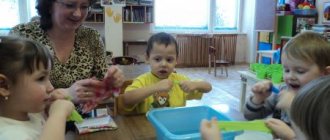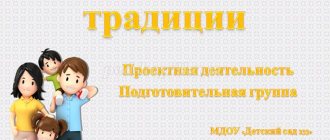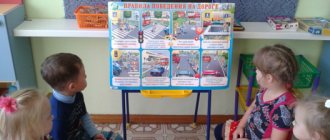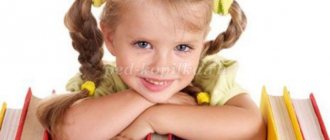MAGAZINE Preschooler.RF
Short-term creative and educational project “Fairy Tales for Children” for the preparatory group of a preschool educational institutionMunicipal autonomous preschool educational institution kindergarten No. 8 “Planet of Childhood” of a combined type, Moscow region, Reutov
Project manager: teacher of the first qualification category Manastyrnaya I.L.
EXPLANATORY NOTE:
Relevance:
Books are of great importance in a person’s life. A child’s strong interest in reading and reading habit are formed in the family. While the child is small, parents read books to him, and as soon as the baby learns to read on his own, they breathe a sigh of relief. It's no secret that many children grow up without loving a book. Most often, children read comics, sticker magazines, watch videos, play computer games, but the art book remains untouched and loses its importance in the formation of artistic taste. Children and their parents spend most of their free time watching TV or a computer; as a result, the reading process slows down and interest in the book is lost. Reading fiction is of great importance for the all-round development of a child. Their success in learning depends on how children understand the content of what they read, how they can read fluently and expressively, analyze the actions of characters, and draw conclusions.
Once a child begins to become interested in a book, he will find himself in a completely different world - fascinating, colorful, interesting, which will give him many discoveries and finds. The love of reading and books is a love for life, so it is very important to encourage a preschooler’s first successes in reading and storytelling, and to stimulate his interest in words and good works.
A homemade book made by preschoolers will increase interest in fiction, give an understanding of the importance of books in a person’s life and increase children’s self-esteem for their work.
A homemade book is both entertainment and a pastime with a child, as well as learning.
The most fertile soil, with unlimited developmental and educational opportunities, is a fairy tale.
Fairy tales reveal to children the precision and expressiveness of language, showing how rich native speech is in humor, lively and figurative expressions. The amazing power of linguistic creativity of the Russian people has never manifested itself as clearly as in folk tales. Their inherent extraordinary simplicity, brightness, imagery, and ability to repeatedly reproduce the same speech forms and images make it possible to put forward fairy tales as a factor in the development of coherent speech in children.
Hypothesis:
A fairy tale has an advantage over other educational techniques. This is a kind of moral code of the people, their heroics are, although imaginary, but examples of the true behavior of an honest person who knows how to stand up for his dignity.
A fairy tale plays a crucial role in the development of imagination - an ability without which neither the mental activity of a child during preschool and school education, nor any creative activity of an adult is possible. Fairy tales instill interest in reading fiction.
Problem:
Difficulties in children developing coherent speech, the sequence of stories about the events of their lives, the ability to retell literary works, compiling stories based on a picture and a series of pictures, and compiling descriptive stories. Children's creative abilities are poorly developed.
Target:
To cultivate in children a love of books, as well as a love of Russian folk tales; develop in children a sustainable interest in fairy tales as a work of art; revealing children's creative abilities.
Tasks:
- To increase children's interest in independent reading activities.
- To develop the ability to plan the process of making a book - babies.
- Expand children's understanding of fairy tales.
- To develop in children the ability to independently select literature of interest.
- Development of fine motor skills of the hands.
- To develop imaginative thinking, imagination, and creative abilities in children.
- Foster feelings of friendship and collectivism.
- Foster a culture of speech.
- Foster love and respect for books.
- Education of aesthetic taste.
Planned results:
- Increasing the effectiveness of work on the development of coherent speech in children.
- Enriching children's vocabulary.
- Children’s use of elements of Russian folklore, comparisons, metaphors, epithets and other means of figurative expression in their speech.
- The ability to play didactic and printed board games, solve and compose your own riddles, solve crosswords and puzzles based on Russian folk tales.
- Application of acquired knowledge, skills and abilities in creative activities (creating a baby book).
Expected results for the project:
- developing children's interest in Russian folk tales;
- consolidating the ability to apply one’s knowledge in conversation and coherent statements;
- fostering a sense of friendship and collectivism;
- get an emotional response from your work;
- replenishing the book corner with homemade books made with your own hands.
Project implementation stages.
Stage 1 Preparatory
- arouse children's interest in the chosen project topic;
- invite children to bring books with their favorite fairy tales from home to the group;
- examination of illustrations for Russian folk tales “Zayushkina’s Hut” , “The Wolf and the Seven Little Goats” , “Masha and the Bear” , “The Fox with a Rolling Pin” , “Geese-Swans” ;
- design of a book center in a group;
- selection of visual and didactic material.
Stage 2 Main
- Implementation of the project plan with children;
- examination of illustrations of Russian folk tales;
- reading and telling Russian folk tales, talking about the fairy tales read;
- conversation with children “What is a fairy tale?” ;
- conducting board-printed, didactic, verbal games;
- guessing riddles based on fairy tales;
- creation of a card index of Russian folk tales;
- creation of a homemade book and a castle from a fairy tale, illustration of paper puppet fairy tale heroes;
- dramatization of fairy tales.
- Final stage
- Summing up the results of project activities;
- telling fairy tales from your books to children in the preparatory group;
- theatricalization of fairy tales.
| Next > |
Preparatory group. Senior preschool age. Children 6-7 years old
Photo report on the educational and creative project in the preparatory group “The Christmas tree - the beauty came to visit us”
Report of an educational and creative project in the preparatory group “The Christmas tree - the beauty came to visit us”
.
The goal of the project : to arouse children's interest in the world around them.
To form realistic ideas about nature, to expand children’s knowledge about coniferous trees. Introduce... Research and creative project “Visiting Santa Claus” for children of the preparatory group Duration: short-term (2 weeks)
Dates:
Project : teachers, children, parents. Age of children: 6 – 7 years. Relevance of the project . November 18 marks the birthday of Father Frost, and children have become interested in the life of Father Frost, his concerns, his friends….
Examples of projects in preschool educational institutions
We suggest considering the short-term project “Winter” in the preparatory group. The main purpose of it is to introduce children to the seasons. First, the teacher tells the children about what is typical for such a time of year as winter. The teacher pays special attention not to the climatic features of a given period, but to the traditions with which this period is so rich. As homework, children are invited to remember New Year's traditions together with their parents and come up with riddles about the New Year. In the second lesson, the guys share the information they managed to find. The teacher introduces the children to “different” Santa Clauses. This can be done using a computer presentation. In addition, preschoolers will learn about the New Year traditions that exist in different countries.
This project is best carried out in November-December. The second homework will be making New Year's toys. But first, the teacher introduces children to the types of Christmas tree decorations and how to make them.
The final lesson for the “Winter” project will be a presentation of New Year’s decorations and hanging them on the Christmas tree. After the Christmas tree is decorated with hand-made toys (with the help of parents), the kids will find themselves in a fairy-tale forest, where treats and fun games await them.
Project in the preparatory group of a kindergarten on the topic: New Year
Project passport for the preparatory group “New Year at the Gates.”
Author: Antonova Tatyana Gennadievna Description of the material: Dear colleagues, I bring to your attention the publication of a project passport for the preparatory group “New Year at the Gates”. This material may be useful to preschool teachers, primary school and additional education teachers. In December 2016, the preparatory group of MADOU DS “Talent”, under the leadership of T.G. Antonova and G.R. Amirova, worked on the implementation of the “New Year at the Gate” project. If you are interested in the “New Year at the Gates” project, in the section of the same name on my blog you can find all the material we have developed on this project, as well as get acquainted with the products of the project. I can say from myself that the process of implementing the project and its result exceeded all our expectations. The project goal has been achieved. Our students found answers to all their questions. Thanks to the creative cooperation of a team of children, parents and teachers, an atmosphere of New Year's magic reigned in our group. The group of children has established warm, friendly relationships. The New Year's holiday, according to the Administration of the Medical Educational Institution DS "Darovanie" and the reviews of parents, was held at a high level. I would like to express my gratitude to the teachers who participated in the project for their creative approach to their work and professional competence. Special thanks to the parents of the preparatory group, the teacher of the Children’s Educational Institution “Darovanie” G.A. Ezheleva, for their help in implementing the project.
Purpose of publication: Dissemination of teaching experience among the community of colleagues. Project in the preparatory group of MADOU DS “Talent” “New Year at the Gates”. Teachers Antonova T.G., Amirova G.R. Characteristics of the project Type of project: informational - educational, creative. Project participants: preparatory group children, parents, teachers, music director, speech therapist. Project duration: short-term, December. Relevance: We often remember how good it was in our childhood, what wonderful holidays there were at that time. So, what prevents us, adults, from making an unforgettable holiday for today's children? So that when they grow up, they remember their childhood as the happiest time in their lives. What holiday can unite adults and children, white and black, men and women, those who believe in miracles and those who doubt? The only holiday that unites all people on the planet is the New Year holiday. Children are looking forward to New Year's miracles, writing letters to Santa Claus, and preparing as best they can. Parents, too, in their own way, prepare for this holiday. The task of teachers is to unite children and parents in a single creative process in order to create an atmosphere of New Year's holiday magic in the group. A passion for joint creativity will provide a comfortable, emotionally prosperous environment in the group and will contribute to the development of communication skills and cooperation. Little ones have a lot of questions: “Where does Santa Claus live?”, “Why do we decorate the Christmas tree?”, “Why is there a star on the top of the tree?” and so on. The implementation of this project involves studying, preserving and implementing the traditions of celebrating the New Year, which helps satisfy children’s cognitive interest in this holiday and their need for creative activity. While working on the project, preschool children will find the answer to all their questions, learn how to make New Year's decorations, get the opportunity for successful self-realization, and will be able to experience the situation of success. The problem is significant for children, the solution of which the project is aimed at : During the conversation with children “What kind of holiday is the New Year? And how will we prepare for this holiday? It turned out that preschoolers have more questions than answers. Children know that they need to decorate the Christmas tree, but they don’t know why they should decorate the Christmas tree. All preschoolers know that they need to decorate their home, group, they can make decorations and gifts with their own hands, but they find it difficult to answer how to make this a reality. As a result of the conversation, the preschoolers came to the conclusion - In order to prepare well for the New Year's holiday, we must first find answers to all the questions that interest us, learn how to make New Year's decorations and gifts with our own hands and decorate our group, prepare an interesting New Year's performance and invite our parents to please their. We outlined the problem of the project as follows: Do we want New Year's magic and celebration? So we all need to work hard. The goal of the project: to involve and unite a team of children, parents and teachers in joint creative activities. Creation of conditions that stimulate interest in research activities, development of cognitive interest, disclosure of the creative and intellectual potential of older preschoolers. Project objectives: For children: Educational:
1. To cultivate a respectful attitude towards the cultural heritage of our country, a kind attitude towards your loved ones and relatives, surrounding children, adults;
2. Contribute to the unity of the children's team, the development of friendly relationships, communication skills and interaction in the children's team; 3. Development of the child’s self-esteem, and the ability to evaluate and appreciate the achievements of peers. Educational:
1. To form the cognitive interest of preschoolers;
2. Expand and systematize the knowledge of preschoolers about the history and traditions of the New Year holiday in Russia and other countries; 3. Introduce children to works of fiction about the celebration of the New Year (fairy tales, stories, poems); 4. Introduce New Year-themed musical works (songs, dances, plays); 5. Enrich and develop children's active vocabulary. Developmental:
1. Develop children's communication skills;
2. Create an atmosphere of joint creativity in the children's team; 3. Continue to develop children's creativity, imagination, thinking and memory; 4. Contribute to the development of creative initiative and search activity of preschoolers. For teachers: 1. Increase the level of creative competence of teachers; 2. Ensure the quality of the pedagogical process through the use of modern methods and technologies; 3. Create conditions for constructive interaction with the families of pupils for the purpose of further cooperation. For parents: 1. Promote the active involvement of parents of pupils in the activities of preschool educational institutions; 2. Increase the psychological and pedagogical competence of parents. Expected results for the project: For children: 1. Broadening the horizons of children; 2. Uniting the children's team; 3. Development of individual creative abilities of preschool children and interest in collective creative activities; 4. Self-realization of preschoolers. For teachers: 1. Increasing competence in the use of modern pedagogical technologies in educational activities; 2. Realization of creative potential; 3. Self-education. For parents: 1. Optimization of parent-child relationships; 2. Increasing the level of parental involvement in the activities of preschool educational institutions. Project products 1. Organization and creation of a subject-game holiday environment, group design; 2. Participation in the New Year’s crafts competition “Santa Claus’s Workshop”; 3. Holding a New Year's party. The role of parents in the implementation of the project: 1. Creative interaction with children and teachers in the thematic design of the group; 2. Participation in the competition for making New Year’s crafts “Santa Claus’s Workshop”; 3. Sewing and purchasing New Year's costumes for children for the holiday. Participation of specialists: Musical director Anikina L.M. – musical accompaniment of the project, preparation of musical numbers for the holiday. Teacher Chapurina N.A. - staging dance numbers. Speech therapist Degtyareva A.Sh. articulation (in the group of sound disorders) and finger gymnastics, automation of the production of sounds in poetry, tongue twisters and tongue twisters. Forms of project implementation: 1. Games; 2. Classes; 3. Reading fiction;; 4. Discussion; 5. Conversations; 6. Guessing riddles; 7. Examination of plot paintings 8. Theatricalization; 9. Productive activities of children; 10. Examination of illustrations; 11. Memorizing poetry; 12. Learning songs and dances; 13. Writing stories; 14. Excursion; 15. Observation; 16. Solving problem situations; 17. Listening to music; 18. Watching cartoons. Project implementation stages: Stage I – Preparatory 1. Collection of information on the topic; 2. Creation of the necessary conditions for the implementation of the project; 3. Selection of material for productive activities; 4. Selection of audio and video materials; 5. Selection of fiction on the topic; 6. Selection of didactic material; 7. Selection of riddles on the topic; 8. Making a card index of outdoor games; 9. Development of activities; 10. Design of folders - transfers for parents; 11. Discussion with parents of issues related to the project. Stage II – Project implementation Cognitive development Direct educational activities:
Familiarization with the environment “Where the Christmas tree came to us from”, “Hello winter - winter”, “Winter fun”.
Conversations:
“How did they celebrate the New Year in the old days?”, “Why do people decorate the Christmas tree?”, “How old is Santa Claus?”, “New Year in different countries”, “Safe New Year”.
(Appendix No. 1) Didactic games:
“Wonderful bag”, “The fourth odd one”, cut-out pictures “Winter-winter”, “Dangerous - not dangerous”.
Presentation screening:
“Ritual symbolism and characters.”
(Why does the holiday take place around a Christmas tree? About the history of the New Year’s toy), “Where does Santa Claus live?”, “How do they celebrate the New Year in different countries?” Speech development Reading fiction:
H. Andersen “The Snow Queen”, S. Marshak “Twelve Months”, Gaidar “Chuk and Gek”, V. Suteev “The Christmas Tree”, R.S.
“Morozko”, “Snow Maiden”, V. Zoshchenko “Christmas tree”, collection of poems “A Christmas tree was born in the forest”, collection of poems “When the New Year comes”, Usachev A. “Hello, Grandfather Frost!”, Moskvina M. “Like Grandfather Frost was born." Making riddles
about winter natural phenomena, about the New Year holiday (Appendix No. 2);
Reading and memorizing poems:
I. Surikov “Winter”, Z. Alexandrova “Santa Claus”, according to the content of the script for the New Year's party (Appendix No. 3);
Examination of subject pictures and compilation of descriptive and narrative stories based on them; Artistic and aesthetic development Musical activity: Learning songs about winter, about the New Year holiday, New Year's round dances, dances according to the content of the script; Listening to an audio recording: P. I. Tchaikovsky “Seasons. Winter", "Nutcracker"; Listening to audio recordings of New Year's songs. Productive activity: Drawing
: “Winter Landscape”, “Our Decorated Christmas Tree”, “New Year’s Eve”.
Application: “Red Cockerel - the symbol of 2022”, “Our merry snowman”. Modeling:
“Father Frost and Snow Maiden”, “New Year’s toy”.
Artistic work:
“Santa Claus’s Workshop” making Christmas tree decorations;
Multi-colored garlands made of crepe and colored paper; Christmas tree decorations made of colored paper “Lantern”, “Christmas ball made of multi-colored stripes”, “Smiling snowflake”, “Santa Claus”; Christmas tree decorations made of foil “Silver flowers”; Christmas tree toy made from yarn “Colored hats”; Garland of fir cones; Children’s participation in collective creativity in decorating windows (cutting out palms from paper) and a group room. Thematic coloring pages. Social and communicative development Conversations
“So as not to spoil the holiday”, “How to give and receive gifts correctly”.
Role-playing games
“New Year with the Family”, “New Year’s Gift Shop”.
Watching themed cartoons
.
Excursion
“The Main Christmas Tree of Tashly”.
Physical development Outdoor games:
“Snow Woman”, “Red Nose Frost”, “Two Frosts”, “Snow, Blizzard, Blizzard”
“Winter Fun”:
Relay races and competitions at the site of the children’s choice, slide riding, sledding
New Year’s entertainment games
(Appendix No. 4)
Work with parents: 1. Safety briefing “Fire safety rules during New Year’s events”; 2. Design of a mobile folder: “Why should children believe in Santa Claus” (Appendix No. 5); 3. Updating and supplementing information in the parent’s corner; 4. Parents making New Year’s crafts “Santa Claus’s Workshop”; 5. Help from parents in decorating the group’s New Year’s decorations; 6. Tips for parents on making carnival costumes for children; 7. Decorating New Year's gifts for children. Stage III - Final 1. Participation of the preparatory group in the New Year's crafts competition "Santa Claus's Workshop"; 2. Participation of the preparatory group in the competition “Best New Year’s decoration of the group” 3. New Year’s holiday. 4. Discussion with children about the results of teamwork, relaxation. 5. Summing up the project. Project presentation. Dissemination of work experience among colleagues and on Internet resources. Applications to the project can be viewed here /blogs/tatjana-genadevna-antonova/prilozhenija-k-proektu-novyi-god-u-vorot.html
We recommend watching:
Scenario of a New Year's fairy tale for the preparatory group Scenario of the New Year's matinee in the preparatory group New Year's entertainment for children of senior preschool age New Year's in the preparatory group. Scenario
Similar articles:
New Year's scenario for older preschoolers
New Year's scenario for children of the preparatory group
New Year's holiday scenario for preschoolers 5-7 years old
Lesson on the topic: New Year in kindergarten for children of senior preschool age
A surprise moment for the New Year in kindergarten. Preparatory group
Classification of projects in preschool educational institutions
How are short-term projects divided in preschool educational institutions? The preparatory group works according to new federal standards. They involve the classification of projects by the number of participants, target setting, and duration.
The following options are mainly used in preschool institutions:
- Creative and research forms. Children conduct interesting experiments, presenting the results in the form of newspapers, theatrical performances, and role-playing games.
- Role-playing and game projects. They contain individual elements of games in which children play the main roles.
- Practice-oriented information works. The kids collect the material and then design it.
- Creative projects involve holding children's parties and excursions.
"World of Water"
By implementing this short-term project, children not only become familiar with the most important substance on Earth, but also learn to respect water resources.
The teacher tells his kids that they are 90 percent water. To attract the attention of preschoolers to the topic of the project, he can tell them a fairy tale about a droplet, which during its journey turned into steam, then into ice, then back into a droplet. This way the children will get acquainted with the aggregate states of water and its circulation in nature. There is also a practical part to this project. Kids learn to “turn” water into ice using refrigerators. Aesthetic skills are also required in this activity. Armed with ordinary sheets of white paper and scissors, young designers create snowflakes of unusual shape and size. Together with the teacher, the children attach threads to the finished products, and such homemade decorations are used for New Year trees.
The “World of Water” project involves the involvement of a music worker from a preschool educational institution. He introduces the children to songs that mention water, snow, ice. The result of such cooperation will be learning a song about water, snow, rain. Everyone chooses a song together: the teacher, the music worker, the children.



